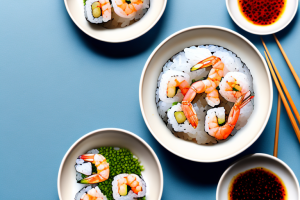How to make sushi rice with teriyaki salmon
9 min read
A plate of sushi rice topped with teriyaki salmon
If you’re a fan of sushi, you know that the rice is an essential component of any roll. But have you ever considered making your own sushi at home? With a little practice and the right ingredients, you can create your own sushi masterpiece right in your own kitchen. In this article, we’ll walk you through all the steps to make sushi rice with teriyaki salmon that will rival any restaurant.
Why sushi rice is the perfect companion for teriyaki salmon
Sushi rice is a short-grain, sticky rice that is perfect for making sushi rolls. It is cooked with vinegar and sugar to create a slightly sweet and sour flavor that complements the savory flavor of teriyaki salmon perfectly. The texture of sushi rice is also ideal for rolling and shaping into sushi rolls.
In addition to its flavor and texture, sushi rice is also a healthier option compared to other types of rice. It has a lower glycemic index, which means it doesn’t cause a rapid spike in blood sugar levels. Sushi rice is also a good source of protein, fiber, and essential vitamins and minerals. So not only does it taste great with teriyaki salmon, but it also provides important nutrients for a balanced diet.
A step-by-step guide to making perfect sushi rice
To make perfect sushi rice, you need to start with the right ingredients and follow a few simple steps. Begin by rinsing 2 cups of sushi rice under cold water until the water runs clear. Then, add the rice to a saucepan with 2 1/4 cups of water and bring to a boil. Reduce the heat to low, cover the pot, and simmer for 12 minutes. Once the rice is cooked, remove it from the heat and let it sit for 10 minutes before fluffing it with a fork.
One important tip to keep in mind when making sushi rice is to use a wooden spoon or paddle to mix the rice. This is because metal utensils can react with the vinegar used in sushi rice and affect the taste. Additionally, it’s important to use high-quality sushi rice vinegar to achieve the perfect balance of sweetness and acidity in the rice. With these tips in mind, you’ll be able to make delicious sushi rice that’s perfect for your favorite sushi rolls.
How to season your sushi rice for maximum flavor
Once your sushi rice is cooked, it’s time to add the seasoning. In a small saucepan, mix together 1/4 cup of rice vinegar, 1 tablespoon of sugar, and 1 teaspoon of salt. Heat the mixture over low heat until the sugar dissolves. Then, pour the mixture over the cooked sushi rice and gently fold it in with a spatula. Allow the rice to cool to room temperature before using it in your sushi rolls.
Did you know that the type of rice you use can also affect the flavor of your sushi? Short-grain Japanese rice is the most commonly used type of rice for sushi because of its sticky texture and mild flavor. However, you can also experiment with other types of rice, such as brown rice or black rice, to add a nutty or earthy flavor to your sushi. Just be sure to adjust the cooking time and water ratio accordingly.
The secret ingredient to perfectly cooked teriyaki salmon
The key to perfectly cooked teriyaki salmon is not overcooking it. Overcooked salmon will be dry and lack flavor. To ensure that your salmon is perfectly cooked, use a meat thermometer to check the internal temperature. The salmon should be cooked to an internal temperature of 145°F. Another secret to perfectly cooked teriyaki salmon is to marinate it in teriyaki sauce prior to cooking. This will infuse the salmon with flavor and help keep it moist while cooking.
Aside from using a meat thermometer and marinating the salmon in teriyaki sauce, there are other tips to keep in mind when cooking teriyaki salmon. One important tip is to use a non-stick pan or a well-oiled grill to prevent the salmon from sticking. This will also help to keep the salmon intact and prevent it from falling apart while cooking.
Another tip is to let the salmon rest for a few minutes after cooking. This will allow the juices to redistribute throughout the fish, resulting in a more flavorful and moist dish. Finally, consider adding some garnishes to your teriyaki salmon, such as sliced green onions or sesame seeds, to add some extra flavor and texture to the dish.
Tips for selecting the best salmon for your sushi rolls
When selecting salmon for your homemade sushi rolls, look for fresh, high-quality salmon. Choose salmon that has a bright orange color and a fresh, clean smell. Avoid salmon that looks dry or discolored. If you’re not sure what kind of salmon to buy, ask for help from your fishmonger.
Another important factor to consider when selecting salmon for your sushi rolls is the type of salmon. There are different types of salmon, such as Atlantic, Chinook, Coho, and Sockeye, each with their own unique flavor and texture. Atlantic salmon is typically farm-raised and has a milder flavor, while wild-caught salmon, such as Chinook and Sockeye, have a richer flavor and firmer texture. Consider the flavor and texture you prefer when choosing the type of salmon for your sushi rolls.
How to prepare and marinate salmon for teriyaki sauce
To prepare salmon for teriyaki sauce, start by filleting the salmon and removing any bones. Cut the salmon into bite-sized pieces and set it aside. In a small bowl, mix together 1/4 cup of soy sauce, 2 tablespoons of honey, 1 tablespoon of rice vinegar, 1 teaspoon of garlic powder, and 1 teaspoon of grated ginger. Pour the marinade over the salmon and let it marinate in the refrigerator for at least 30 minutes prior to cooking.
For an extra burst of flavor, you can also add some sesame oil or sesame seeds to the marinade. This will give the salmon a nutty and slightly sweet taste that pairs perfectly with the teriyaki sauce. Additionally, if you want to make the dish more colorful and nutritious, you can add some sliced bell peppers, onions, or carrots to the marinade. These vegetables will absorb the flavors of the marinade and complement the salmon’s taste and texture.
When cooking the salmon, you can either grill it, bake it, or pan-fry it. If you choose to grill it, make sure to oil the grates and preheat the grill to medium-high heat. Place the salmon on the grill and cook for about 4-5 minutes per side, or until it is cooked through. If you prefer to bake it, preheat the oven to 400°F and place the salmon on a baking sheet lined with parchment paper. Bake for 12-15 minutes, or until the salmon is flaky and tender. Finally, if you decide to pan-fry it, heat some oil in a non-stick pan over medium-high heat. Add the salmon and cook for 3-4 minutes per side, or until it is golden brown and cooked through.
A foolproof recipe for homemade teriyaki sauce
To make a homemade teriyaki sauce, mix together 1/2 cup of soy sauce, 1/4 cup of brown sugar, 1 tablespoon of cornstarch, 1/4 cup of water, and 1 tablespoon of grated ginger in a small saucepan. Cook over medium heat, stirring constantly, until the sauce thickens and the sugar has dissolved. Use the teriyaki sauce to marinate the salmon or as a dipping sauce for your sushi rolls.
Homemade teriyaki sauce is not only easy to make, but it is also healthier than store-bought versions that often contain preservatives and additives. Additionally, you can customize the recipe to your liking by adjusting the sweetness or adding other flavors such as garlic or sesame oil.
Another great way to use homemade teriyaki sauce is as a glaze for grilled meats or vegetables. Simply brush the sauce onto your favorite protein or veggies during the last few minutes of cooking for a delicious and flavorful finish.
Assembling your sushi roll with precision and ease
To assemble your sushi roll, lay out a sheet of nori on a sushi mat. Spread a thin layer of sushi rice over the nori, leaving a 1-inch border at the top. Arrange the teriyaki salmon on top of the rice and add any additional fillings, such as cucumber or avocado. Use the sushi mat to roll the sushi tightly, pressing down gently as you roll to ensure that the sushi is compact. Use a sharp knife to slice the sushi roll into bite-sized pieces.
Expert tips for slicing your sushi rolls like a pro
To slice your sushi rolls like a pro, start by wiping your knife with a damp cloth to prevent the rice from sticking. Hold your sushi roll with one hand and use the other hand to slice the roll into even-sized pieces. Use a gentle sawing motion to cut through the roll, taking care not to squash the sushi. You can also use a sharp serrated knife for a cleaner cut.
How to present and serve your homemade sushi rolls with style
To present your homemade sushi rolls, arrange them on a platter and garnish with pickled ginger, wasabi, and soy sauce. Add a sprig of fresh parsley or cilantro for a pop of color. Use chopsticks or a fork to eat your sushi rolls, taking care to dip them into a small bowl of soy sauce for added flavor.
Variations on the classic teriyaki salmon sushi roll
There are endless variations on the classic teriyaki salmon sushi roll. Try adding thinly sliced cucumber or avocado for added texture and flavor. You can also experiment with different types of fish, such as tuna or shrimp, or try vegetarian fillings like carrots or sweet potato. The possibilities are endless!
Pairing wine and sake with your homemade sushi dinner
When it comes to pairing wine and sake with sushi, the goal is to find a wine or sake that complements the flavors of the sushi without overpowering them. A light, crisp white wine like Pinot Grigio or Sauvignon Blanc works well with sushi, as does a dry sake. For a sweeter sake, try a fruity, aromatic white wine like Riesling or Gewurztraminer.
Quick and easy ways to make sushi without a bamboo mat
If you don’t have a bamboo mat, you can still make sushi at home using a few simple tricks. Use a piece of plastic wrap or a clean, damp kitchen towel to roll your sushi instead of a bamboo mat. You can also use a kitchen gadget like a sushi bazooka or sushi maker to help shape your sushi rolls.
Frequently asked questions about making sushi at home
Q: Is sushi easy to make at home?
A: With a little practice and the right ingredients, sushi is easy to make at home.Q: Do I need special equipment to make sushi at home?
A: While a bamboo mat is helpful, you can make sushi at home using plastic wrap or a damp kitchen towel to roll your sushi. You can also use a sushi bazooka or sushi maker to help shape your sushi rolls.Q: What kind of rice should I use for sushi?
A: Sushi rice is a short-grain, sticky rice that works best for making sushi. Look for sushi rice at your local grocery store or Asian market.Q: Can I make sushi ahead of time?
A: Sushi is best served fresh, but you can prep all your ingredients ahead of time and assemble your sushi rolls just before serving.Q: Is it safe to eat raw fish in sushi?
A: As long as the fish is fresh and has been properly handled and stored, it is safe to eat raw fish in sushi. If you’re unsure about the quality of the fish, ask your fishmonger or choose cooked fish or vegetarian fillings instead.


